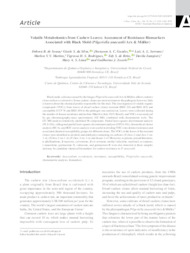Volatile metabolomics from cashew leaves: assessment of resistance biomarkers associated with Black Mold (Pilgeriella anacardii Arx & Müller).
Volatile metabolomics from cashew leaves: assessment of resistance biomarkers associated with Black Mold (Pilgeriella anacardii Arx & Müller).
Author(s): SOUSA, D. B. de; SILVA, G. S. DA; GUEDES, J. A. C.; SERRANO, L. A. L.; MARTINS, V. V.; RODRIGUES, T. H. S.; BRITO, E. S. de; ZAMPIERI, D.; LIMA, A. S.; ZOCOLO, G. J.
Summary: Black mold, a disease caused by the fungus Pilgeriella anacardii Arx & Müller, affects cashews (Anacardium occidentale). Some cashew clones are more resistant to the pathogen; however, little is known about the chemical profile responsible for this trait. The investigation of volatile organic compounds (VOCs) from leaves of dwarf cashew clones resistant (BRS 226 and BRS 265) and susceptible (CCP 76 and BRS 189) to the pathogen was carried out. Leaves were collected during the months of disease incidence and decline (March to July 2019, Brazil), and VOCs were analyzed by gas chromatography-mass spectrometry (GC-MS) combined with chemometric tools. The GC-MS analysis tentatively identified 96 compounds. Partial least squares discriminant analysis (PLS-DA), orthogonal partial least squares discriminant analysis (OPLS‑DA), hierarchical cluster analysis (HCA), and ROC curves analysis were useful in dividing VOCs into distinct resistance and associated chemical susceptibility groups for different clones. The VOCs in the leaves of the resistant clones were identified as alcohols and aldehydes containing six carbons: (E)-hex-2-enal, hex-3-en- 1-ol, (Z)-hex-2-en-1-ol, (E)-hex-2-en-1-ol, and hexan-1-ol. Moreover, α-pinene, pseudolimonene, α-phellandrene, β-myrcene, sylvestrene, β-cis-ocimene, methyl salicylate, myrtenol, α-copaene, γ-muurolene, germacrene D, valencene, and germacrene B were also detected in these samples and may be candidate chemical biomarkers for cashew resistance to P. anacardii.
Publication year: 2022
Types of publication: Journal article
Observation
Some of Embrapa's publications are published as ePub files. To read them, use or download one of the following free software options to your computer or mobile device. Android: Google Play Books; IOS: iBooks; Windows and Linux: Calibre.
Access other publications
Access the Agricultural Research Database (BDPA) to consult Embrapa's full library collection and records.
Visit Embrapa Bookstore to purchase books and other publications sold by Embrapa.

